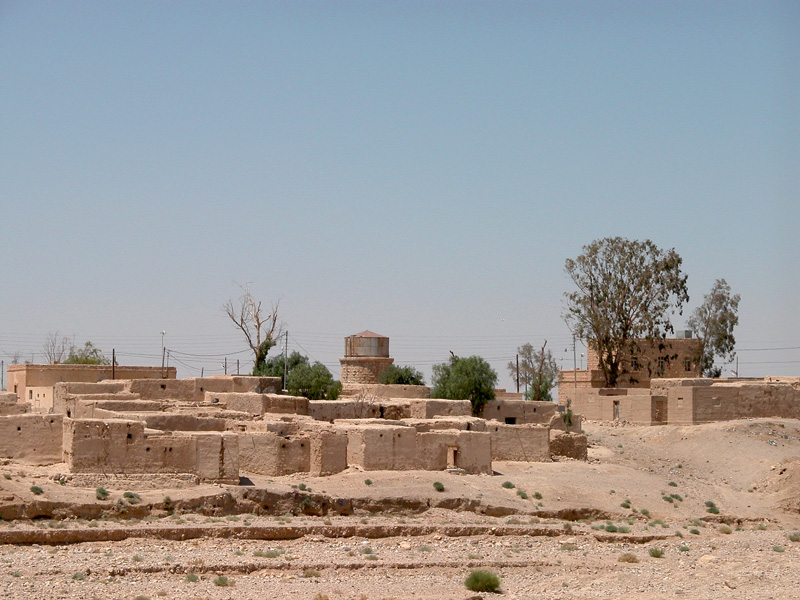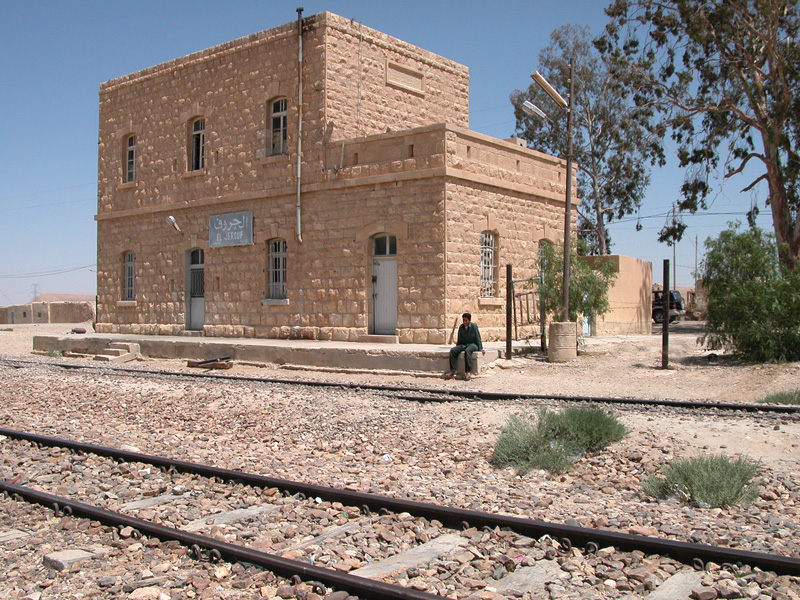Km. 398
By now, driving on the smooth highway begins to have a soothing, hypnotic effect. It is difficult to tell the speed of the car as all landmarks are far away, moving very slowly. All along the ride from Amman to Aqaba, villages and towns show hardly any charm. One exception is the village of Jurf Al Daraweesh.

From the highway you glimpse a beautifully knit group of houses, shady alleys, a big tree, and one dominating red-roofed structure, all adding to a picturesque and balanced composition. As the car moves on the highway, the village rotates, changing angels, and as shady walls turn around to show sunny ones, the mud-roofs retain their maximum glare. The monochrome of the village and its wider landscape helps to accentuate the shadows, which become, from a distance, the only way to perceive the rotating forms. Viewing the village in motion adds different angles to the same composition, exactly the way cubism artists did in their paintings.
The current state of preservation of this village is a mere chance. Somehow, or maybe due to the cliff, the highway missed passing too near it. The small valley between the village and the highway acts like a natural moat, and its western cliff forms a pedestal that gives the houses extra elevation. The valley also made it difficult for construction to cross and gather by the sides of the modern highway, which would have concealed the traditional village and destroyed its purity.
Like the classic description of small railway-centered village, the stone buildings of the train station form the heart of the village. The front feels like a harbor or a port on a waterfront where the village connects to the rest of the bigger and more important outside world. The residential part is only to the east of the tracks, making is easier for all to live together without crossing to the other side of the station. Beyond the rails to the west, the empty flat landscape gives the feeling of an open sea.

While the station architecture is typical of engineering designs of western public buildings of the early 20th century, the residential neighborhood is of simple houses in human scale, most likely built in the same period of the station.
Besides the construction of the station, which started around one century ago, the central historic event of this place took place shortly after, in 1918, when the army of the Great Arab Revolt under the leadership of Prince Zaid bin Al Hussain arrived from the eastern desert, from Bayer and Al Jafr, to launch an attack on Tafileh. The capture of Jurf Al Daraweesh produced big amounts of spoil from the Turks, 80 were killed and some 200 captured. It is said that the inhabitants evacuated the village three days later, following the Hashemite troops to join in the battle of Tafileh.
Jurf al Daraweesh is out of the movies. The scale, color, massing, and proportions are typical of Jordan’s first half of the 20th century. Is the charm of this place the result of the failure of our modern architecture and “town-planning” to create meaningful built environment?
This village was saved by chance. It gives us a perfect time-capsule, so far pure of any clashing interventions. We may think of securing its advantages as an original place for film-making, instead of investing in fake castles in sensitive environmental areas.
If you are a frequent traveler on the desert highway, you must have seen this village many times before. Jurf al Daraweesh is about half the way between Amman and Aqaba, visible at a comfortable distance across a small valley to the west of the road. From Amman, after driving for about 150 km on the Desert Highway, Jurf al Daraweesh is on the exit to Tafileh. Driving on the Tafileh road for about 200 meters will bring you to the southern end of the village where you can find its main road. For general photographs, you can simply stop on the Desert Highway as it passes east of the village and, with a zoom, capture good stretches of traditional architectural fabric with the desert in the background. This destination should be visited on the way to Petra, Wadi Rum or Aqaba. All what you need is to have 20 to 30 minutes extra. Jurf al Daraweesh is a photogenic place, it provides a good background for still photography and a magical one for movies.